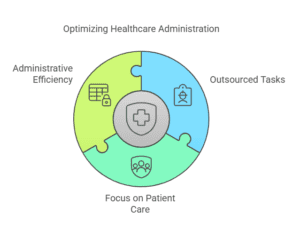On-Demand Outsourcing BPO Services for Healthcare Providers With 24/7 Coverage!
Save up to 70% on staffing costs!
Browse Specialty Staffing ServicesAchieving Better Results with Healthcare Workflow Optimization

Healthcare providers are under constant pressure to deliver top-quality patient care while juggling substantial administrative challenges. From managing insurance verifications to handling prior authorizations, these tasks consume valuable time and resources. Healthcare workflow optimization offers a practical solution, helping providers streamline operations, reduce inefficiencies, and improve overall productivity. By addressing workflow gaps, providers can focus more on patient care rather than getting bogged down by paperwork.
Achieving true healthcare workflow optimization requires tackling administrative burdens head-on. This means automating repetitive tasks, improving communication, and leveraging outsourcing solutions to handle time-consuming processes like medical billing and credentialing. When workflows are optimized, patient satisfaction improves, costs decrease, and healthcare teams experience less burnout—creating a win-win situation for both providers and their patients.
Understanding Healthcare Workflow Optimization
In simple terms, healthcare workflow optimization fine-tunes the steps that doctors and healthcare professionals take to deliver care more efficiently. This includes automating repetitive administrative tasks, improving communication, and enhancing team coordination. By leveraging innovative tools like virtual medical assistants, healthcare practices can streamline operations while keeping their primary focus on patient care.
Addressing workflow bottlenecks, such as prior authorization delays and provider credentialing challenges, is also crucial for efficiency. Incorporating these improvements into a healthcare workflow optimization strategy helps providers achieve smoother operations and better patient outcomes. For many healthcare organizations, outsourcing to healthcare BPO services has become an essential solution for managing back-office tasks more effectively.

Key Elements of Workflow Optimization
Automating Administrative Tasks
Time-consuming processes such as scheduling, billing, and data entry can consume valuable hours. Technology like virtual medical assistants eliminates manual steps, freeing up caregivers to focus on patients. For instance, automating appointment reminders can reduce no-shows and improve clinic efficiency.
Streamlining Communication
Poor communication channels between departments can lead to errors and delays. Integrating centralized communication tools enhances collaboration and keeps every stakeholder informed in real-time.
Enhancing Patient Experiences
Workflow optimization isn’t just about internal processes—it significantly impacts patients. Reducing wait times, ensuring accurate billing, and improving front-line staff responsiveness all lead to better experiences for your patients.
Explore services designed to enhance healthcare workflows here.
Benefits for Healthcare Providers
Reduced Burnout
Doctors and staff often face burnout due to high administrative workloads. Efficient workflows alleviate this strain, enabling teams to focus entirely on patient care.
Financial Performance Improvements
Optimized workflows help cut excess operational costs and improve revenue streams. healthcare workflow optimization Tasks like insurance verification and revenue cycle management (RCM) become more accurate, reducing financial errors and ensuring prompt payments.
Increased Focus on Care
With fewer administrative distractions, providers can dedicate more time to improving patient outcomes. Expediting provider credentialing and reducing waiting times for prior authorization are excellent examples of where time efficiencies translate into better care.
For a deeper dive into how healthcare operations improve patient flow, check this resource: How Healthcare Operations Management Improves Patient Flow.
How Outsourcing Enhances Workflow Efficiency
Outsourcing has emerged as a cost-effective strategy for healthcare providers seeking to optimize workflows. Partnering with professional healthcare BPO services enables organizations to delegate time-intensive tasks, from prior authorization to medical billing.
Cost-Savings
Outsourcing back-office tasks reduces the need for in-house staff, lowering overhead costs while gaining access to skilled professionals.
Improved Accuracy
BPO providers are specialized in areas like RCM, ensuring precision and compliance in healthcare documentation and billing.
For a comprehensive look at outsourcing’s benefits, visit: Benefits of Outsourcing in Healthcare.
Top Services to Consider Outsourcing
Medical Billing and Coding
Outsourcing billing processes enhances cash flow, reduces errors, and ensures compliance with insurance regulations.
Provider Credentialing
Credentialing can be tedious and time-consuming, but outsourcing speeds up the process while meeting credential verification standards.
Insurance Verification
Accurate and timely insurance verification prevents denied claims and ensures smooth payment processes.
To better understand how healthcare providers use outsourcing techniques, check out examples here: Role of Outsourcing in Healthcare.
Case Studies: Proven Results
One hospital saw a significant reduction in their prior authorization delays after outsourcing this service. Read about other success stories here: Benefits of Outsourcing in Healthcare.
Steps for Implementing Workflow Optimization
Conducting a Workflow Audit
Start by evaluating your current processes to identify inefficiencies. Map workflows to spot redundancy or misaligned resources.
Leveraging Technology and Expertise
Innovative tools like virtual medical assistants and external expertise from BPO services help bridge workflow gaps quickly. These tools deliver insights and handle tasks accurately.
Collaborating with professionals ensures a smoother transition while adopting new systems. For more ideas, explore: How to Optimize Telemedicine Workflows.
Conclusion
Optimizing healthcare workflows isn’t just about doing tasks faster—it’s about creating a more efficient, patient-focused system. From reducing burnout to enhancing financial performance, these changes significantly benefit providers. Outsourcing to BPO providers further amplifies these benefits by reducing administrative burdens. Interested in transforming your operations? Find out how Staffingly helps healthcare providers achieve workflow excellence.
What Did We Learn?
Healthcare workflow optimization focuses on making processes more efficient, reducing administrative burdens, and enhancing patient care. Moreover, by automating repetitive tasks, improving communication, and outsourcing time-consuming responsibilities, healthcare providers can streamline operations while also dedicating more time to their patients.
For example, services like medical billing, insurance verification, and provider credentialing play a crucial role in optimizing workflows. As a result, healthcare providers can cut costs, reduce errors, and ensure greater accuracy. Ultimately, a well-structured healthcare workflow optimization strategy benefits both providers and patients by improving efficiency, reducing delays, and enhancing overall care quality.
What People Are Asking?
1. What is healthcare workflow optimization?
Healthcare workflow optimization is the process of improving operational efficiency by automating tasks, streamlining communication, and reducing administrative burdens to enhance patient care.
2. How does workflow optimization benefit healthcare providers?
It reduces staff burnout, improves financial performance, minimizes errors, and allows providers to focus more on patient care instead of administrative tasks.
3. What are common bottlenecks in healthcare workflows?
Prior authorization delays, inefficient provider credentialing, poor communication, and manual administrative tasks like scheduling and billing are common challenges.
4. How does outsourcing help with healthcare workflow optimization?
Outsourcing tasks like medical billing, insurance verification, and prior authorization speeds up processes, improves accuracy, and reduces costs by leveraging expert healthcare BPO services.
5. What are the best tasks to outsource for better workflow efficiency?
Medical billing & coding, provider credentialing, insurance verification, and revenue cycle management are top services that improve workflow efficiency when outsourced.
Disclaimer
For informational purposes only; not applicable to specific situations.
For tailored support and professional services,
please contact Staffingly, Inc. at (800) 489-5877
Email : support@staffingly.com.
About This Blog : This Blog is brought to you by Staffingly, Inc., a trusted name in healthcare outsourcing. The team of skilled healthcare specialists and content creators is dedicated to improving the quality and efficiency of healthcare services. The team passionate about sharing knowledge through insightful articles, blogs, and other educational resources.
 Book a Demo to Build Your Team Today!
Book a Demo to Build Your Team Today!
 Read Case Studies
Read Case Studies 



 Virtual Medical Assistants
Virtual Medical Assistants



